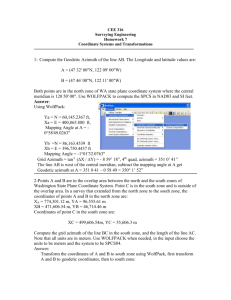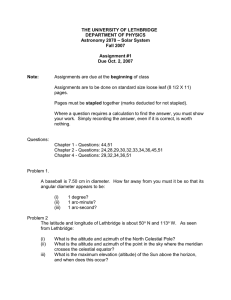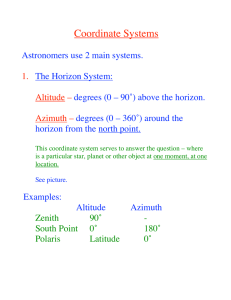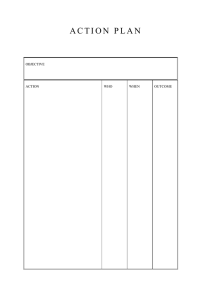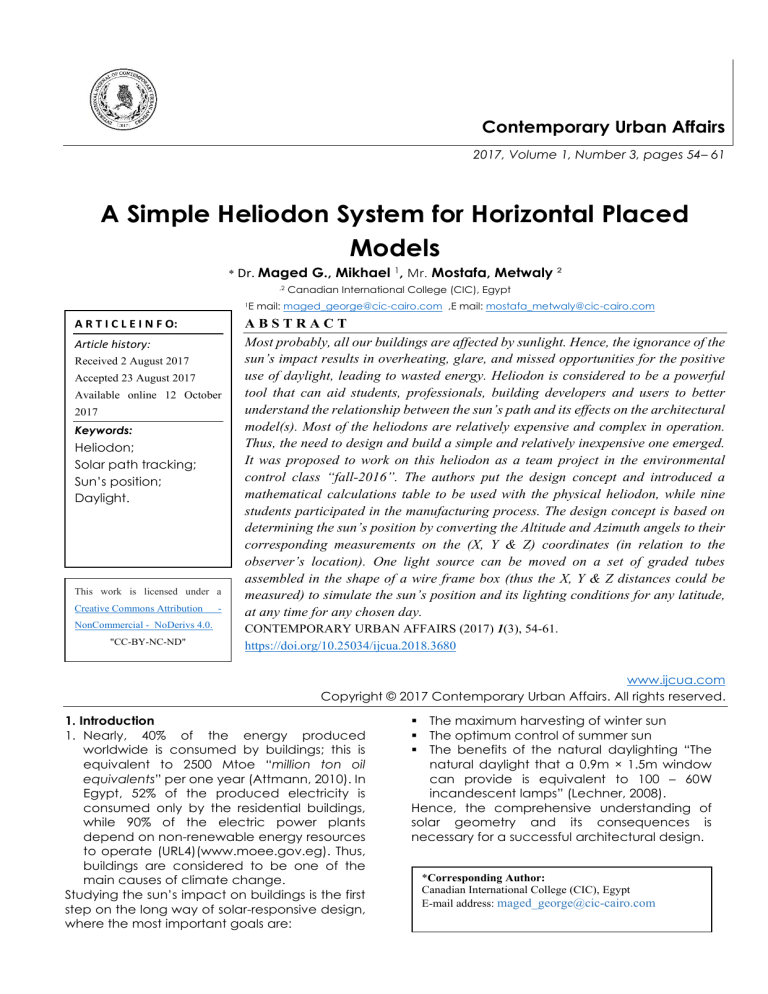
Contemporary Urban Affairs
2017, Volume 1, Number 3, pages 54– 61
A Simple Heliodon System for Horizontal Placed
Models
* Dr. Maged
,2
1
A R T I C L E I N F O:
Article history:
Received 2 August 2017
Accepted 23 August 2017
Available online 12 October
2017
Keywords:
Heliodon;
Solar path tracking;
Sun’s position;
Daylight.
This work is licensed under a
Creative Commons Attribution
NonCommercial - NoDerivs 4.0.
"CC-BY-NC-ND"
-
G., Mikhael 1, Mr. Mostafa, Metwaly ²
Canadian International College (CIC), Egypt
E mail: maged_george@cic-cairo.com ,E mail: mostafa_metwaly@cic-cairo.com
ABSTRACT
Most probably, all our buildings are affected by sunlight. Hence, the ignorance of the
sun’s impact results in overheating, glare, and missed opportunities for the positive
use of daylight, leading to wasted energy. Heliodon is considered to be a powerful
tool that can aid students, professionals, building developers and users to better
understand the relationship between the sun’s path and its effects on the architectural
model(s). Most of the heliodons are relatively expensive and complex in operation.
Thus, the need to design and build a simple and relatively inexpensive one emerged.
It was proposed to work on this heliodon as a team project in the environmental
control class “fall-2016”. The authors put the design concept and introduced a
mathematical calculations table to be used with the physical heliodon, while nine
students participated in the manufacturing process. The design concept is based on
determining the sun’s position by converting the Altitude and Azimuth angels to their
corresponding measurements on the (X, Y & Z) coordinates (in relation to the
observer’s location). One light source can be moved on a set of graded tubes
assembled in the shape of a wire frame box (thus the X, Y & Z distances could be
measured) to simulate the sun’s position and its lighting conditions for any latitude,
at any time for any chosen day.
CONTEMPORARY URBAN AFFAIRS (2017) 1(3), 54-61.
https://doi.org/10.25034/ijcua.2018.3680
www.ijcua.com
Copyright © 2017 Contemporary Urban Affairs. All rights reserved.
1. Introduction
1. Nearly, 40% of the energy produced
worldwide is consumed by buildings; this is
equivalent to 2500 Mtoe “million ton oil
equivalents” per one year (Attmann, 2010). In
Egypt, 52% of the produced electricity is
consumed only by the residential buildings,
while 90% of the electric power plants
depend on non-renewable energy resources
to operate (URL4)(www.moee.gov.eg). Thus,
buildings are considered to be one of the
main causes of climate change.
Studying the sun’s impact on buildings is the first
step on the long way of solar-responsive design,
where the most important goals are:
The maximum harvesting of winter sun
The optimum control of summer sun
The benefits of the natural daylighting “The
natural daylight that a 0.9m × 1.5m window
can provide is equivalent to 100 – 60W
incandescent lamps” (Lechner, 2008).
Hence, the comprehensive understanding of
solar geometry and its consequences is
necessary for a successful architectural design.
*Corresponding Author:
Canadian International College (CIC), Egypt
E-mail address: maged_george@cic-cairo.com
JOURNAL OF CONTEMPORARY URBAN AFFAIRS, 1(3), 54-61 / 2017
Starting from the very early model made by
Dufton-Bachett in 1931, passing by that one
developed by George Malcolm Beal in 1953
(Beal, 1957), and till the most recent models of
Lechner 2001 and his successors, heliodons have
been considered one of the most powerful tools
that can aid students, professionals, building
developers and users to better understand the
relationship between a building and the sun
(Lechner, 2001).
Since heliodons have been developed mainly to
study the effect of the sunlight on a given
building(s) model, three main variables are
always the dominant constraints for any
heliodon design concept, these variables are:
Latitude determines the relation between the
sun’s path and the geographical location on
the earth’s surface.
Day of the year: specifies the declination of
the sun on a specific day.
Time of the day: determines the sun’s position
between the east and the west (Cheung,
2000).
These three variables guide the researcher to
obtain two angels that help to allocate the sun’s
position (Figure 1). These two angels are:
Altitude (ALT): Measured upwards from the
horizon where the observer’s location is at the
center of the skydome.
Sun’s position (X, Y & Z)
S
Imaginary sky dome radius
The Z coordinate
The Y coordinate
E
The Azimuth angel
Sky dome radius projection
The X coordinate
Sky dome center
(location of the observer)
The Altitude angel
W
N
Figure 1. Converting the sun’s position parameters from the angels - Altitude & Azimuth - system to the coordinates - X, Y & Z –
system.
Azimuth (AZI): measured in the horizontal
plane from north or south (Szokolay, 2008).
Heliodon designs could be classified into two
groups, depending on the positions of both of
the light source and the building model:
Tilted / moving building model while the light
source (s) is either fixed or moving.
Fixed (horizontal) building model while the
light source is moving (Cheung, 2011).
A quick glance on both of the two types
declares that the first type has significant
disadvantages: Holding the model in steep
angels may result in difficulty in viewing or
causing it to slide out of position. Furthermore, it
doesn’t simulate our everyday experience of the
sun moving across the skydome. Meanwhile, the
fixed building model types are complicated to
manufacture and operate, relatively large (for
more accuracy) thus, require larger space
during operation and / or storage (most of
them), and to somehow more expensive (URL3)
(www.heliodon.org).
2. The Need for This Heliodon
Our target in the environmental control class was
to encourage the students to build their own
heliodon, taking into consideration that it should
be easy to understand, can be constructed
inside the CIC campus with simple tools, requires
a relatively small space during both operation
and storage and relatively inexpensive. To
achieve the previous goals, the fixed building
model type was selected; the concept of
converting both of the Altitude and the Azimuth
angels to their corresponding (X, Y & Z)
coordinates (Figure 1) “with a moving single light
source to simulate the sun’s position” was
chosen. The UPVC pipes and connections were
proposed as a construction material for the
heliodon, “relatively rigid and cheap”, while the
Maged G., Mikhael, Mostafa, Metwaly
55
JOURNAL OF CONTEMPORARY URBAN AFFAIRS, 1(3), 54-61 / 2017
5cm thick rigid foam and 5mm thick white
cardboard were the materials for the base.
Design concept and calculations, supervision
and the orientation of the manufacturing
process were the authors’ tasks, while the
construction was accomplished by a group of
nine students.
3. Solar Position Calculations
The authors relied on external software
“SunPosition” to determine the ALT & AZI angels
of the sun’s position for any latitude, on any day
of the year and at any time of the day. Also, to
generate the necessary input data to build a
calculations table that will be used in the design
and
manufacturing
process
of
the
heliodon(URL5)(www.susdesign.com/sunposition
).
The main function of the calculations table is to
change the parameters of the sun’s position
from the “ALT and AZI angles system” to the
coordinates system through a series of
equations. The “SunPosition” software was
chosen for two main reasons:
It is comprehensive software, but yet, with an
easy interface for students’ interaction.
It is open-source software, which can be
accessed online easily and freely by students.
3.1The Calculations Table
The authors designed an excel spreadsheet linked to the “SunPosition” output data file - to
generate the main calculations table that will
help the students to determine all the needed
data and measurements to construct and
operate their heliodon. The table was designed
with two groups of data as follows:
The input data group (Table 1-a):
Latitude & Longitude: measured in degrees and
generated automatically based on the value
that was entered manually by the student on the
“SunPosition” software to define the exact
location for calculation.
Time zone: measured in hours and generated
automatically based on the value that was
entered manually by the student to the
“SunPosition” to define the exact location for
calculation.
Date of the day: a unit-less pre-set data, its
values represent a predefined range of days for
tracking the solar path over the year with oneday interval (1st. of Jan. – 31st. of Dec.).
Time of the day: a pre-set data, measured in
hours, its values represent a predefined range of
13 hours for tracking the solar path over the day
with one-hour interval (06 – 18).
Zero azimuth direction (North or South): choosing
North (N) or South (S) as the zero Azimuth
direction (ZAD) is generated automatically
based on the selection that was previously
entered manually by the student on the
“SunPosition”, and it is set to the following rule: if
the North is the zero Azimuth direction then its
value = 1 and the South value = 0, and vice
versa.
Original Altitude & Azimuth angles: can be
obtained
from
the
“SunPosition”
in
correspondence with a pre-set time value; it is
measured in degrees and entered manually by
the student to the calculations table.
The output data group (Table 1-b):
Absolute Azimuth angel: measured in degrees
and generated automatically based on the
input value of the original Azimuth angle
“regardless the zero Azimuth direction”.
The correction factor for the Azimuth angel:
measured
in
degrees
and
generated
automatically, its value is either (0 or 180) based
on the input value of the Zero Azimuth Direction
(180 in case of the ZADN=1 and 0 in case of the
ZADS =1).
Corrected Azimuth angle: measured in degrees
and generated automatically based on the
input value of the zero Azimuth direction (N or S),
the output value of the Azimuth angle correction
factor and the output value of the absolute
angle.
Skydome radius: a pre-set data that is measured
in centimeters; its value represents the maximum
allowable movement distance of the light
source in any direction starting from the
heliodon’s origin point (Observer’s point).
The distances on the (Z) coordinate: measured in
centimeters; it is generated automatically based
on the output values of the Altitude angle / Sine
and the pre-set value of the skydome radius.
The Z Coordinate movement direction:
measured in (+) only.
The distances on the (Y) coordinate: measured
in centimeters, and is generated automatically
based on the values of skydome radius
projection on the horizontal plane and the
Azimuth angle cosine.
The Y coordinate movement direction:
measured either in (+) or in (-); its values are
generated automatically based on the output
values of Y coordinate distance, the input
values of ZAD (N or S) in addition to the output
values of absolute Azimuth angel.
Maged G., Mikhael, Mostafa, Metwaly
56
JOURNAL OF CONTEMPORARY URBAN AFFAIRS, 1(3), 54-61 / 2017
The distances on the X Coordinate: measured in
centimeters; it is generated automatically based
on the output values of skydome radius
projection in addition to the output values of the
distance of Y coordinate.
The X coordinate movement direction:
measured either in (+) or in (-); its values are
generated automatically based on the output
values of the distance on the X coordinate, the
pre-set values of time, the input values of the
ZAD (N or S) in addition to the input value of the
original Azimuth angle.
4.1VALIDATION OF THE CALCULATIONS TABLE
OUTPUT
To validate the output data that was obtained
from the calculations table “for specific latitude
and a certain time of a certain day” it was
important to compare it with a reference data
for the same variables. The latitude of 30.04 N
(Cairo – Egypt) was chosen and the hours from
(6 – 18) for the longest and shortest days of the
year (21st. of June and 21st. of December) were
selected for the validation. The output data
results “the measuring distances on the X, Y and
Z coordinates” for Cairo – Egypt at the selected
hours on the
Table 1-a. Sample of the input data group (The 21st. June & the 21st. December at noon time)
Latitude
Variables
Data Type
Units
Values
Values
Longitude
Time
Zone
Date
Month
Time
Zero
Altitude
Azimuth
Azimuth Direction
Angle
Angle
North
South
Original
Original
"1" = Yes "1" = Yes
"0" = No "0" = No
Input (,)
Input (,) Input (,) Pre-set Pre-set Input (,) Input (,) Input ($) Input ($)
"Degrees" "Degrees" "Hours" "---" "Hours"
"---"
"---"
"Degrees" "Degrees"
30.0444 N 31.2357 E GMT 2 21-Jun 12:00
0
1
083.360
006.260
30.0444 N 31.2357 E GMT 2 21-Dec 12:00
0
1
036.490
001.950
Table 1-b. Sample of the output data group (The 21st. June & the 21st. December at noon time)
Azimuth
Sky Dome
"Z"
Sky Dome
"Y"
"X"
Angle
Radius
Coordinate
Radius
Coordinate
Coordinate
Absolute Correction Corrected
Rate
Direction Projection
Rate
Direction
Rate
Direction
Factor
Opp. 01
Hyp. 01
Adj. 01
Adj. 02
Opp. 02
"0" / "180"
Hyp. 02
Output (#) Output (#) Output (#)
Pre-set
Output (#) Output (#) Output (#) Output (#) Output (#) Output (#) Output (#)
1
"Degrees" "Degrees" "Degrees"
"cm"
"cm"
"+"
"cm"
"cm"
"+" / "-"
"cm"
"+" / "-"
006.260
0
006.260
100
099
+
012
011
001
001.950
0
001.950
100
059
+
080
080
003
Figure 2. Output data of (Sun-Path Projections - 1 &
Grasshopper - 2) at noon time, 21st. December for Cairo –
Egypt
Chosen days were exported to “Grasshopper”
software(URL2)(http://www.grasshopper3d.com
/) to generate the corresponding solar path
diagrams. When the solar path diagrams
generated by “Grasshopper” were compared
to those generated by reference software “SunPath Projections” for the same variables the
results were identical (Figure 2).
4. Heliodon Construction
For the purpose of learning in the environmental
control Lab., the skydome radius was selected to
be 100cm “this could be greater or smaller
according to the available space, the required
2
accuracy and the scale of the model(s) understudy”.
The UPVC pipes were cut and assembled “with
connections” to construct a wireframe like box
“a bit larger to allow the light source to move
100cm in the three coordinates” as shown
(Figure 3 & 7). The (Pz1, Pz2, Pz3 & Pz4) pipes were
Maged G., Mikhael, Mostafa, Metwaly
57
JOURNAL OF CONTEMPORARY URBAN AFFAIRS, 1(3), 54-61 / 2017
graded (0 to 100cm) “using a sticker measuring
tape” to illustrate the measuring units on the Z
coordinate, (Px1 & Px2) pipes were graded from
their midpoints (0 to 100cm & 0 to -100cm) to
illustrate the measuring units (+ & -) on the X
coordinate and finally (Py) pipe was graded
from its midpoint (0 to 100cm & 0 to -100cm) to
illustrate the measuring units (+ & -) on the Y
coordinate. Bolts (B1, B2, B3 and B4) can be
loosened to allow (Px1and Px2) pipes to move
freely up and down on the (Pz1, Pz2, Pz3 and Pz4)
pipes or can be tightened to fix them in the
required Z coordinate position (Figure 4). Bolts (B5
and B6) can be loosened allowing the (Py) Pipe
to move feely to the right or to the left on (Px1
and Px2) pipes
Detail -3B3
Pz2
B6
Py
Px2
B4
B2
Detail -1-
Pz3
B5
PZ1
10:00
Coordinates:
(45cm, 44cm, 85cm)
PX1
Imaginary Sky Dome
Detail -2-
21st. September Sun Path –
Cairo
Tested 3D Model
PZ4
B1
Figure 3. The proposed heliodon illustrates the effect of the sunlight on a building model .
Measuring Tape, Y (+)
UPVC Tee 90, D 1"
UPVC Tube Px1, D 3/4"
UPVC Tube Py, D 3/4"
UPVC Union, D 3/4"
UPVC Connection Tube, D 3/4"
Measuring Tape X (+)
UPVC Reducing Bush, D 1"- 3/4"
Measuring Tape X (-)
Fixing
Bolt B5
“21st. September at 10:00, Cairo-Egypt”
Figure 4. Detail 1.
Maged G., Mikhael, Mostafa, Metwaly
58
JOURNAL OF CONTEMPORARY URBAN AFFAIRS, 1(3), 54-61 / 2017
Measuring
tape, Y (-)
Electrical cord
Fixing bolt B
UPVC
Tee 90, D 1"
Measuring
tape, Y (+)
UPVC Tube,
3/4"
Edison screw
lamp holder
Incandescent
Lamp
Figure 5. Detail -2-
Measuring Tape Z (+)
Measuring Tape X (-)
UPVC Tee 90, D 1"
UPVC Tube Px1, D 3/4"
UPVC Union, D 3/4"
Fixing Bolt B1
UPVC Connection Tube, D 3/4"
UPVC Tube Pz4, D 3/4"
UPVC Reducing Bush, D 1"- 3/4"
Figure 6. Detail 3.
or can be tightened to fix it in the required X
coordinate position (Figure 5). A (100W)
incandescent lamp was used as a light source to
simulate the sunlight rays and it can move back
and forth on the (Py) Pipe to reach the required
Y coordinate position and simulate the sun’s
position (Figure 6). The base was made of 5cm
thick rigid foam between two layers of “100cm ×
70cm × 5mm” cardboard sheets.
Figure 7. The students during the manufacturing and
assembling of the heliodon
4.2Operation of the Heliodon
After the installation process “previously
described” the student can follow the next steps
to track the solar path and study the effect of
the sun light on his building model:
Prepare the building model and put it in the
origin point of the heliodon (the model should
Maged G., Mikhael, Mostafa, Metwaly
59
JOURNAL OF CONTEMPORARY URBAN AFFAIRS, 1(3), 54-61 / 2017
be oriented with respect to the four cardinal
directions).
Determine the latitude of the building, date of
the day and the time of the selected day.
Use the previous constrains as input data in
the “SunPosition” software (or any similar
software) to generate the corresponding
Altitude and Altitude angels.
Use all the predetermined constrains and the
generated angles as input data in the
designed calculations table to generate the
corresponding measuring distances on the X,
Y and Z coordinates.
Adjust the position of the light source
according to the generated measures on
the heliodon.
Plug in the electrical cable, turn on the lamp
and observe the effect of the light on the
model (Figure 8).
After completing the study turn of the lamp
and unplug the electrical cable.
In case of storage for long periods,
disassemble the heliodon parts and store it.
Altitude angels for any location on the earth’s
surface and at any time for any chosen day.
The designed calculations table played a vital
role during both of the manufacturing and
operation processes.
The Excel sheet that was designed to form the
calculations table relied on the output data of
the “SunPosition” (Azimuth and Altitude angels)
along with the assumption of the sky dome
radius to generate the corresponding X, Y, and Z
measuring distances on the heliodon. The output
data of the calculations table were compared
to external reference software - Sun-Path
Projections - and the results were identical. Thus
the design concept could be verified.
The proposed heliodon was successfully
constructed according to the assumed
measurements in the calculations table, and the
students could use it effectively to study the
effect of the sunlight on their building model(s).
This heliodon could be designed and
constructed with different scales according to
the required accuracy; the available space and
budget, and can be disassembled and stored in
small space for future use.
Tuning & Future Work
We aim to reconstruct this heliodon system with
more durable material (stainless steel pipes),
more efficient bracing system and a LED light
source instead of the incandescent lamp to give
more parallel light rays, thus, a more realistic
sunlight simulation. Also, we hope we can make
a fruitful collaboration with other engineering
specializations to make the system fully operated
and controlled by a commuter system.
Figure 8. Using the heliodon to test the effect of sunlight on a
building model
5. Conclusion
The main target of this work was to encourage
the students in the environmental control class to
participate in the design and the manufacturing
of their own heliodon, hence their awareness of
both of the solar geometry and the solarresponsive design could be enhanced. The
concept of this heliodon is relatively simple as it
depends on the determination of the
relationship between the sun’s position and its
corresponding X, Y and Z coordinates related to
the observer’s location on the earth’s surface.
Relying on external software “SunPosition” was
necessary to generate both of the Azimuth and
Acknowledgement
We would like to give special thanks to our
diligent students who participated in the
construction
process:
Andrew
Ghettany,
Mahmoud
El-Zayaty,
Mohamed
Wahba,
Mohamed Ezz El-Dein, Mohamed Essam,
Mostafa Helal, Omar El-Shahawai, Omar Abd ElGawad and Ziad Hassan.
Also we would like to thank those so special
students of the environmental control class
“Cohort-2014”, a list of their names could be
found
on
the
following
link:
(URL1)(https://drive.google.com/open?id=0BbNxtEORp3VTUdWVXlaYldLdVk).
Maged G., Mikhael, Mostafa, Metwaly
60
JOURNAL OF CONTEMPORARY URBAN AFFAIRS, 1(3), 54-61 / 2017
References
Attmann, O. (2010). Green Architecture:
Advanced Technologies and Materials.
McGraw-Hill Professional, 11-13.
Beal,G.M.(1957). Natural Light and the InsideOutside Heliodon, University of Kansas
publications. the bulletin of engineering and
architecture, 38, 12-13.
Cheung, K.P. (2000). A Multi-Lamp Heliodon for
Architectural Schools, International Journal of
Architectural Science, 1(1), 46-58.
Cheung, K.P. (2011). A Discussion on the Design
Principles of a Patented Portable Direct
Sunlight
Light-Duty
Universal
Heliodon
Mounted on a Camera Tripod. International
Journal of Architectural Science, 8(4), 98-113.
Lechner, N. (2001). The Sun Emulator: A
Conceptually Clear Heliodon. Proceedings
of the ASCA “Association Colligate Schools
of Architecture” Technology conference,
116-118.
Lechner, N. (2008). Heating, Cooling, Lighting:
Sustainable Design Methods for Architects,
3rd. Ed., NY, USA, John Wiley & Sons,.404.
Szokolay, S.V. (2008).
Introduction to
Architectural
Science:
The
basis
of
Sustainable Design, 2nd. Ed., Elsevier, USA, 2224.
URL1
https://drive.google.com/open?id=0BbNxtEORp3VTUdWVXlaYldLdVk
URL2
http://www.grasshopper3d.com/
URL3
http://www.heliodon.org
URL4
http://www.moee.gov.eg/english_new/EEHC_Re
p/2014-2015en.pdf (pp.18 & pp.43)
URL5
http://www.susdesign.com/sunposition/index.php
Maged G., Mikhael, Mostafa, Metwaly
61

